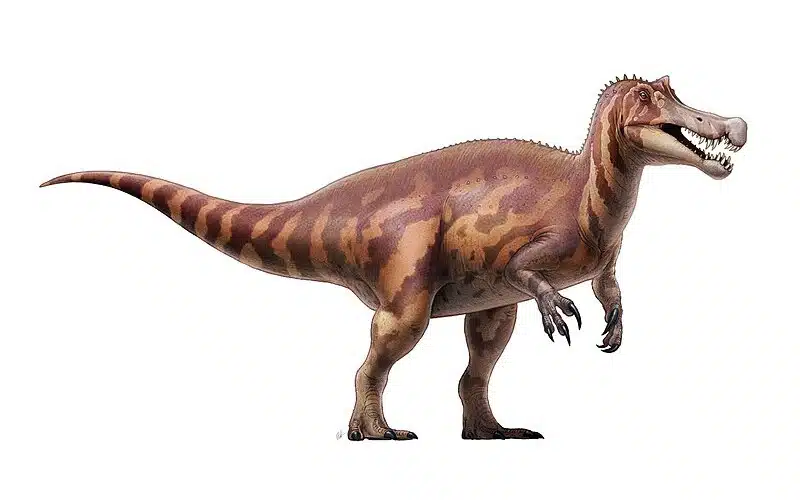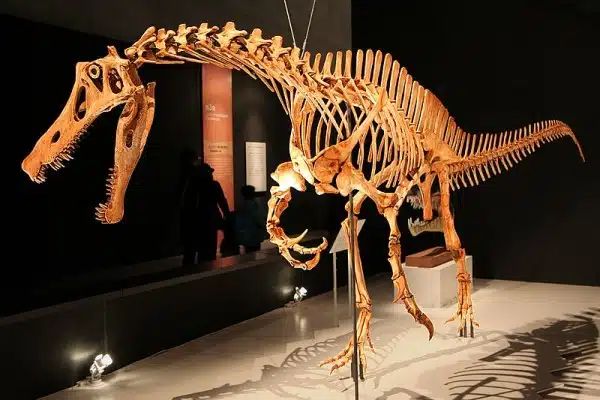When we delve into the world of dinosaurs, every now and then we come across a name that piques our curiosity. Irritator is one such fascinating prehistoric creature. Its name is a reflection of the frustration felt by paleontologists due to the altered state of its fossil, which is just the beginning of its intriguing story. Discovered in Brazil in 1996, this dinosaur offers a glimpse into a world that existed over 120 million years ago.
Irritator, a member of the Spinosaurid family, roamed the Earth during the Early Cretaceous Period. Its discovery not only added a new chapter to the book of ancient life but also raised questions about the diversity and evolution of Theropods. This carnivorous dinosaur has since captivated the imagination of scientists and enthusiasts alike.
Irritator Key Facts
| Keyword | Fact |
|---|---|
| Pronunciation | ee-ruh-tay-tr |
| Meaning of name | Frustration of Paleontologists |
| Group | Theropod |
| Type Species | Irritator challengeri |
| Synonym Species | Angaturama limai |
| Diet | Carnivore |
| When it Lived | 122.46 to 112.03 MYA |
| Period | Early Cretaceous |
| Epoch | Late/Upper Aptian |
| Length | 20.0 to 33.0 feet |
| Height | Approximately 7.0 feet |
| Weight | Approximately 4.0 tons |
| Mobility | Moved on two legs |
| First Discovery | 1996 from unknown Fossil Dealers |
| Described by | 1996 by David Martill, A. R. I. Cruickshank, Eberhard “Dino” Frey and P. G. Small |
| Holotype | SMNS 58022 |
| Location of first find | Romualdo Formation of the Araripe Basin, Brazil |
Irritator Origins, Taxonomy and Timeline
The genus name, stemming from the word “irritation”, amusingly echoes the exasperation of paleontologists who discovered the skull’s altered state. The species name pays tribute to Professor Challenger, a character from Arthur Conan Doyle’s novels, specifically The Lost World.

Initially, there was some confusion about its classification. It was first thought to be a Pterosaur, then a Maniraptoran dinosaur, until its true identity as a Spinosaurid Theropod was established in 1996. The holotype skull underwent extensive preparation, leading to a detailed redescription in 2002 that solidified its place in the Spinosaurinae subfamily.
Irritator, a genus within the Spinosaurid family, takes us back to the Aptian Epoch of the Early Cretaceous Period. This intriguing dinosaur once roamed the lands of what is now Brazil, specifically within the Romualdo Formation of the Araripe Basin. The nearly complete skull that forms the basis of our knowledge about this species was, in a twist of fate, altered by fossil dealers before reaching the State Museum of Natural History Stuttgart. In 1996, this specimen was designated as the holotype of the type species, Irritator challengeri.
Discovery & Fossil Evidence
The first discovery in 1996 in Brazil was a significant moment in the field of paleontology. The details of the discoverer remain unknown, as it was found by fossil dealers who had excavated it from a chalk concretion. The subsequent description by David Martill and his colleagues in the same year marked the beginning of its scientific journey. The holotype, SMNS 58022, serves as a crucial reference for this species.
Later finds and studies have expanded our understanding of this predator, although the number of finds remains limited. The fossils discovered are primarily cranial and offer insights into its physical characteristics and lifestyle. The degree of preservation varies but each specimen contributes to a more comprehensive picture of this intriguing dinosaur.
The taxonomy of Irritator is further complicated by its close relation to Angaturama limai, another Spinosaurid known from a snout tip found in the same geological formations. Some paleontologists suggest that Angaturama limai might be a junior synonym of Irritator, considering their similar origins and fossil evidence. There was even a proposition that the skull parts of these two dinosaurs belonged to the same individual. However, this theory remains uncertain and requires more overlapping fossil material to conclusively determine whether they represent the same species or distinct entities.
- Reconstructed mount of Irritator challengeri
- Outdated reconstruction of the holotype skull (top) based on the interpretations of Martill and colleagues in 1996.[1] Depictions (similar to the one at the bottom) based on this reconstruction were later featured in many dinosaur books and encyclopedias.
- Partial pelvis and accompanying sacral vertebrae of specimen MN 4819-V, referred to a spinosaurine from the Romualdo Formation of Brazil.
- Closeup of reconstructed skull and neck
- Closeup of Irritator’s upper jaw and dentition
Irritator Size and Description
With a snout resembling a modern Indian gharial, this predator was likely more aquatic than terrestrial. It’s easy to imagine this predator lurking just under the surface of the water, searching for prey. Let’s take a closer look at the physical characteristics that make this dinosaur a unique member of the Early Cretaceous.
Size and Weight of Type Species

Irritator challengeri, one of the smaller known Spinosaurids, is estimated to have measured between 20.0 and 33.0 in length and weighed around 4.0 tons. This size estimation places it on the smaller end of the Spinosaurid spectrum, yet its physical adaptations and potential diet indicate a formidable predator in its ecosystem. The combination of its size, distinctive cranial features, and likely powerful musculature paints a picture of a dinosaur well-equipped for survival in its diverse and challenging habitat.
The Dinosaur in Detail
This relatively small member of the Spinosaurid family possessed a unique set of physical characteristics. Its long, slender snout, lined with straight, unserrated conical teeth, was a defining feature and was indicative of its predatory lifestyle. A thin sagittal crest ran lengthwise atop its head, likely serving as an anchor for powerful neck muscles that were essential for its hunting and feeding habits. The nostrils of this dinosaur were positioned unusually far back on the snout, and its jaw was reinforced by a rigid secondary palate, suggesting a strong bite force.
The holotype of Irritator challengeri, belonging to a subadult, is celebrated as the most completely preserved Spinosaurid skull discovered to date. This specimen provides invaluable insights into the anatomy and potential behaviors of this species. The evidence of an individual consuming a Pterosaur, whether through hunting or scavenging, hints at a diverse diet and opportunistic feeding habits.
Like many Spinosaurids, it had several adaptations that hint at an aquatic lifestyle. Its nostrils were positioned away from the tip of the snout, making it possible to breathe while holding much of its jaw underwater. The powerful muscles attached to its sagittal crest would have allowed it to close its mouth quickly, even with water resistance. Its teeth resemble those of modern piscivores (fish-eaters), such as the Indian gharial. This possible semi-aquatic nature and its habitat in a tropical, coastal lagoon environment surrounded by dry regions suggest a versatile and adaptive lifestyle. It likely coexisted with other carnivorous Theropods, turtles, Crocodyliforms, and a plethora of Pterosaur and fish species.
Interesting Points about Irritator
- The name ‘Irritator’ is unique in paleontology, reflecting the frustration of scientists over the altered state of its fossil.
- It belongs to the Spinosaurid family, known for their distinctive cranial features and carnivorous diet.
- It lived during the Early Cretaceous Period, a time of significant evolutionary changes.
- Its discovery in Brazil contributes to our understanding of dinosaur diversity in South America.
- The limited fossil record of Irritator challenges scientists to piece together its life and habits with minimal evidence.
Irritator in its Natural Habitat
This dinosaur was a Spinosaurid of notable adaptability that thrived in the lush and dynamic ecosystems of the Early Cretaceous Period. Its existence in a tropical coastal lagoon environment, bordered by arid regions, paints a picture of a landscape rich in biodiversity and ecological complexity. The mix of aquatic and terrestrial elements provided a fertile hunting ground for such a versatile predator.
In terms of diet, Irritator was likely a generalist, much like modern-day Crocodilians. Its long, slender snout and conical teeth were well-suited for catching fish, suggesting a strong preference for aquatic hunting. However, the discovery of a Pterosaur in the stomach contents of one individual indicates a broader diet. This finding implies that it was not just a fisher but also an opportunistic feeder. Possibly preying on or scavenging small land animals and aerial creatures that ventured too close to the water’s edge.
The potential semiaquatic nature of Irritator adds another layer to its ecological role. If it did indeed spend a significant amount of time in water, it would have been a key predator within the aquatic food chain. Impacting the populations of fish and other small aquatic organisms. Its presence on land would have been equally impactful. Moreover, it would have influenced the behavior and distribution of other terrestrial species within its environment.
Its habitat was shared with a diverse array of contemporaries, including other carnivorous Theropods, turtles, Crocodyliforms, and a rich variety of Pterosaur and fish species. This coexistence in a shared ecosystem suggests a delicate balance of predator-prey relationships, with the Irritator playing a significant role in maintaining ecological equilibrium.
Many details might neven be known. However, the adaptability and resilience of this dinosaur, enabled it to thrive in a world of both water and land.
Contemporary Dinosaurs
Picture the ancient landscapes where Irritator, a feisty and formidable predator, roamed. This dinosaur was not the largest of its kind but certainly had a presence that couldn’t be ignored. Its life was a constant dance of survival and dominance, especially with its contemporaries like Amazonsaurus, Tapuiasaurus, and the fearsome Tyrannotitan.
Amazonsaurus and Tapuiasaurus, both Sauropods, were like the gentle giants of their time. Towering and massive, they primarily focused on the lush vegetation they grazed on. In contrast, our main character, Irritator, was smaller but far more aggressive. Imagine the tension in the air when these different species crossed paths. While there wasn’t direct competition for food – Irritator wasn’t munching on leaves, after all – there was an unspoken rivalry for territory and dominance. The Sauropods, despite their size, would likely prefer to steer themselves and their vulnerable young clear of the feisty Irritator, known for its hunting prowess and sharp instincts.
Then there’s Tyrannotitan, roughly the same size as Irritator but built more robustly. This fellow predator might have been a direct competitor and possibly even a threat. Picture the intense standoffs these two might have had, each assessing the other and calculating the risks of a confrontation. Irritator was likely quick and cunning, perhaps using its agility to outmaneuver the bulkier Tyrannotitan. Their interactions would have been a spectacular display of prehistoric power and strategy as a testament to the survival of the fittest in their ancient, wild world.
Frequently Asked Questions
Irritator lived during the Early Cretaceous Period, approximately 122.46 to 112.03 million years ago.
The first fossil was discovered in Romualdo Formation of the Araripe Basin, Brazil in 1996.
It is a member of the Spinosaurid family, known for their distinctive features and carnivorous nature.
As a carnivore, its diet likely consisted of smaller dinosaurs and other contemporary animals. Most of its diet was likely fish and other aquatic animals.
Its name reflects the frustration of paleontologists over the altered state of its initial fossil discovery.
Sources
The information in this article is based on various sources, drawing on scientific research, fossil evidence, and expert analysis. The aim is to provide a comprehensive and accurate overview of Irritator. However, please be aware that our understanding of dinosaurs and their world is constantly evolving as new discoveries are made.
This article was last fact-checked: Joey Arboleda, 11-30-2023
Featured Image Credit: Fred Wierum, CC BY 3.0, via Wikimedia Commons





